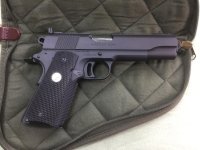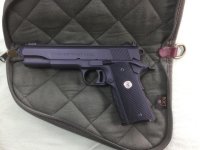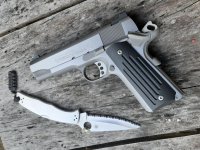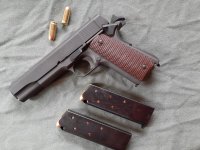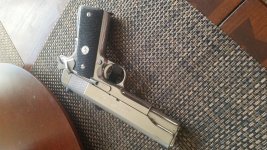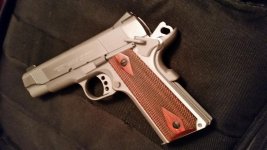Self appointed internet experts claim the short barreled/short slide 1911s are not reliable. That's not the case.
The problem is that shooters buy one and then start trying to "upgrade" it. They'll put in an extra power recoil spring, and or add a shock buffer, without understanding how it can change the dwell time and or slide over run distance for the slide in relation to the magazine well and feeding the next round.
It is true that the slide overrun is reduced on the officer model sized frame 1911s, but the slide over run is sufficient if they don't mess with the springs or add a shock buffer. Simply put the engineering is a little different on the short frame 1911s and you can't aftermarket pimp the internals like a full sized 1911.
The non custom shop Kimbers also often need a break in period to achieve full reliability and too many shooters will put a box through a new one, get a few failures to feed and declare it's not reliable. My Ultra Carry is a good example as it took a couple hundred rounds before it was fully reliable - and has been relentlessly reliable ever since - provided the recoil spring is changed every 800-1000 rounds.
That's another area where officer model frame sized 1911 owners often come up short in not realizing the recoil spring assemblies are shorter lived than in a full size 1911.
Finally, wanna be 1911 shooters in general don't understand the effects of magazine lips and the difference the different lip designs make for ball, RNFP, hollow point and semi wad cutter ammunition.
For example the tapered lip magazine on the left was the standard GI magazine designed for 230 gr FMJ "ball" ammo. For the long 230 gr FMJ round nose bullet it provides silky smooth feeding with full controlled feed of the round. The long tapered lips allow the base of the round to rise gradually as the bullet rides up the feed ramp and it allows the rim to enter the extractor at a low angle.
The tapered feed lip design won't with 100% reliability with a shorter hollow point, RNFP or semi wadcutter as the shorter OAL of the rounds cause the rim to rise too fast/too much before the nose starts to ride up the feed ramp. The end result is a percentage of rounds get driven into the feed ramp at too low an angle and hang up between the frame's feed ramp and the barrel's feed ramp.
Colt developed the hybrid lipped "commercial" magazine design (in the center) in the 1930s to allow shorter OAL rounds to feed better while still working well with the longer 230 gr FMJ. Most commercial 1911s today come with a hybrid lip magazine.
They slow the rise of the base and rim to allow for a better angle at the feed ramp with short OAL bullets. They also release the base of the round sooner to prevent an excessive angle with the longer 230 gr FMJ rounds at the cost of giving up some of the controlled feed and smoothness with 230 gr FMJs. They also don't always feed well with really short 185 gr or lighter semi wad cutters as they still may not have enough up angle when they finally hit the feed ramp. But they are a good compromise for most commonly used factory loads.
The parallel lip or "wad cutter" mag (on the right) has straight, parallel lips that hold the rim down and then suddenly release it. These can cause big problems with 230 gr FMJs as the nose rides well up the feed ramp before the rim is allowed to rise into the extractor. This can cause the rim to jam in the extractor resulting in the round stopping the slide about 1/8" short of being in battery. Worse, it can cause the nose of the bullet to get driven into the space between the barrel and the top of the slide, creating a nasty 3 point jam that requires you to drop the magazine and rack the slide to clear.
With a short semi-wad cutter this feed lip design works well by holding the rim down and then releasing the rim shortly after the nose hits the feed ramp, keeping the angle steep enough to ride up the ramp, and shallow enough to get the bullet in the barrel.
There is also the Wilson 47D magazine that holds the round higher and flatter in front of the breech face. Basically it throws the round up in front of the slide and gives up pretending to be even partially controlled feed. The downside is that the rim often ends up in front of the extractor and the extractor then has to snap over the rim. The wad cutter and Wilson 47D mags are where you see gunsmiths relieving the extractor to both allow the steeper rim angle of the FMJ rounds to still enter the extractor with the wad cutter magazines, or snap over the rim with the 47D magazines.
In short, the combination of OAL, feed lips and extractor profile makes a difference and a shooter who doesn't understand what's going on will have less than perfect reliability - and then blame the gun. In Kimber terms, I've found nearly all Kimbers are very reliable when using Kimber magazines, unless you are using a really short semi wad cutter bullet, where a wad cutter lipped magazine might work better.

